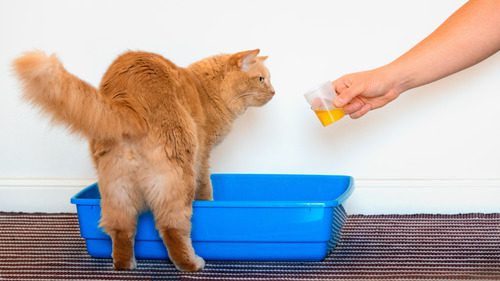Cat UTI Symptoms, Causes, and Treatment

Has your cat ever had a UTI? Urinary tract infections (UTIs) in cats can cause significant discomfort and health issues for your feline friend. As a responsible cat owner, knowing how to recognize the signs, understanding the underlying causes and effective treatment options will enable you to make the most informed decisions about your pet’s health. If you notice any symptoms of a UTI in your cat, contact Bulverde Animal Hospital at (830) 438-7200 or request an appointment online.
What Are Some Cat UTI Symptoms?
Cats with a UTI often display noticeable changes in their behavior and urination habits. Here are some of the most common symptoms to watch for:
- Frequent urination
- Straining to urinate
- Hematuria or blood in the urine
- Urinating outside the litter box
- A strong, unpleasant odor in your cat’s urine
- Excessive licking of the genital area
Possible Causes of UTIs in Cats
UTIs in cats can be caused by various factors, ranging from bacterial infections to underlying health issues.
Bacterial Infections
Bacteria can enter the urinary tract through the urethra and multiply in the bladder, leading to an infection. E. coli is a frequent culprit, but other bacteria can also cause UTIs.
Bladder Stones
These stones can irritate the bladder lining and create an environment where bacteria thrive, leading to an infection.
Feline Lower Urinary Tract Disease (FLUTD)
FLUTD is a complex condition that encompasses various urinary tract issues, including UTIs. Cats with FLUTD often experience recurring UTIs due to inflammation and other urinary tract problems.
Immune System Issues
A weakened immune system can make cats more susceptible to infections, including UTIs. Conditions such as feline immunodeficiency virus (FIV) or feline leukemia virus (FeLV) can compromise a cat’s immune system, increasing the risk of UTIs.
Age and Gender
The anatomical structure of female cats makes it easier for bacteria to enter the urinary tract, while older cats may have weakened immune systems and other underlying health issues.
How Are Cat UTIs Diagnosed and Treated?
At Bulverde Animal Hospital, we use advanced diagnostic tools to identify the cause of your cat’s symptoms and develop a tailored treatment plan.
Diagnosing Cat UTIs
Diagnosing a UTI in cats involves a combination of physical examination, urine analysis, and sometimes imaging tests. Your veterinarian will:
- Perform a Physical Exam: A thorough physical examination helps assess your cat’s overall health and detect any abnormalities.
- Conduct Urine Analysis: A urine sample is analyzed for the presence of bacteria, blood, crystals, and other indicators of infection.
- Use Imaging Techniques: Ultrasound or X-rays may be used to identify bladder stones or other structural issues contributing to the UTI.
Treatment Options
Once a UTI is diagnosed, the treatment plan will depend on the underlying cause and severity of the infection. Common treatment options include:
- Antibiotics: Antibiotics are the primary treatment for bacterial UTIs. Your veterinarian will prescribe an appropriate antibiotic based on the type of bacteria identified in the urine analysis. Complete the entire course of antibiotics to ensure the infection is fully eradicated.
- Pain Management: UTIs can be painful for cats, and managing their discomfort is an important part of the treatment plan. Your veterinarian may prescribe pain relievers to help your cat feel more comfortable during the recovery process.
- Dietary Changes: In cases where bladder stones or crystals are contributing to the UTI, dietary changes may be recommended. Special diets can help dissolve existing stones and prevent the formation of new ones.
- Increased Water Intake: Encouraging your cat to drink more water can help flush out the urinary tract and reduce the risk of future infections. Consider using a cat water fountain or adding wet food to your cat’s diet to increase hydration.
Tips to Prevent Future UTIs in Cats
Preventing future UTIs involves a combination of lifestyle changes, regular veterinary care, and attentive monitoring of your cat’s health.
Regular Veterinary Check-ups
Regular check-ups at Bulverde Animal Hospital allow your vet to help maintain your cat’s overall health and catch any potential issues early. Routine wellness exams and urine tests can help identify and address urinary tract problems before they become severe.
Proper Hydration
Ensure your cat has access to fresh water at all times. Consider using a water fountain to encourage your cat to drink more. Adding wet food to their diet can also help increase their overall water intake.
Healthy Diet
Feed your cat a balanced diet that supports urinary health. Specially formulated urinary diets are available and can help prevent the formation of bladder stones and crystals.
Clean Litter Box
Maintain a clean litter box to reduce the risk of bacterial infections. Scoop the litter box daily and change the litter regularly. A clean litter box environment can encourage your cat to use it consistently and help you monitor their urinary habits.
Stress Management
Provide a calm and enriching environment for your cat, with plenty of opportunities for play and relaxation. Reducing stress can help prevent UTIs and other health problems.
If you suspect your cat is experiencing UTI symptoms or if you have any concerns about their urinary health, contact Bulverde Animal Hospital at (830) 438-7200 or request an appointment online.
Recent Posts
About Us
At Bulverde Animal Hospital, our ultimate goals are excellent service to clients, personal growth, and the professional development of our staff. We are a small clinic creating a significant impact on pets' lives.
